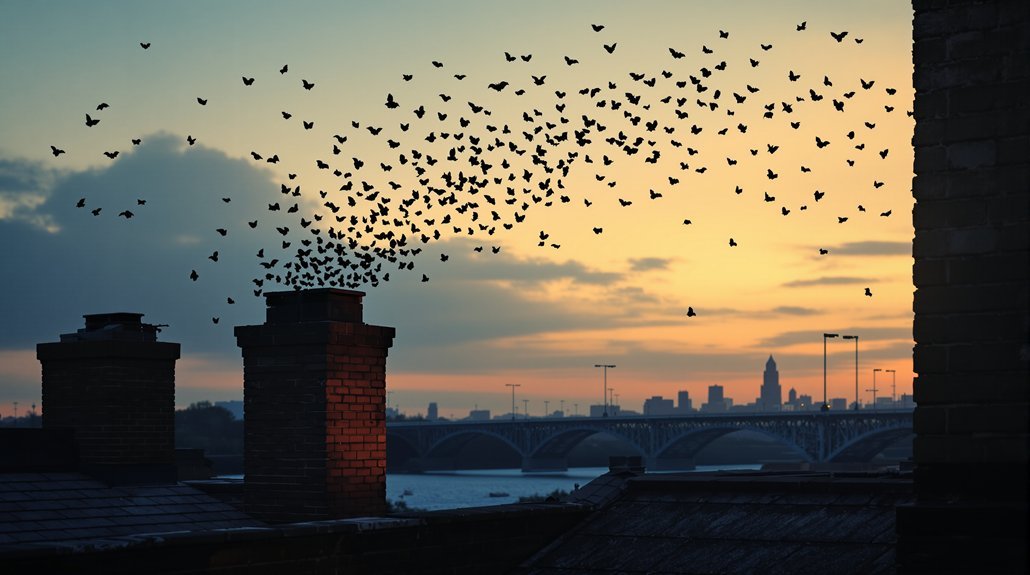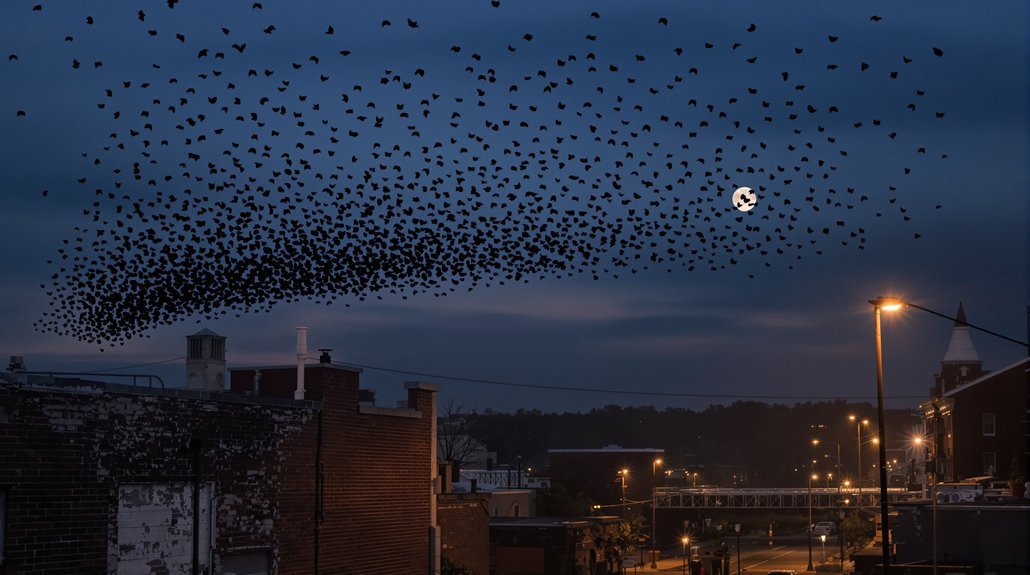Bats in Des Moines do not always return to the same roost each night. Their roosting patterns depend on various factors. Weather changes, food availability, and disturbances can influence their choices. Bats may relocate based on conditions, even though they prefer safe, comfortable spots. They often return to similar areas, but flexibility is key for survival. Understanding these behaviors reveals more about their ecology and the challenges they face in the urban environment.
Key Article Highlights
- Bats do not always return to the same roost each night, as they may relocate based on environmental conditions.
- Factors like weather events, habitat quality, and disturbances can influence bats’ roosting choices in Des Moines.
- Bats typically prefer dark, sheltered spots for roosting, such as attics, barns, and bridges, which may vary nightly.
- While some bats may return to familiar roosts, they often seek new sites based on food availability and safety.
- Urban habitats in Des Moines provide diverse roosting options, affecting bats’ nightly movements and roosting patterns.
Understanding Bat Behavior

How do bats choose their roosting locations? Bats use various methods for roost site selection. One key factor is bat echolocation. This allows them to navigate and detect suitable places to rest. Bats often look for dark, sheltered spots that offer protection from predators and harsh weather. They may prefer areas that provide easy access to food, such as insects. Temperature and humidity also play a role in their choices. Bats are social animals and may choose roosts that allow them to be near other bats. Additionally, entry points such as holes or gaps in buildings often serve as ideal roosting sites. Overall, roost site selection is a complex process. It involves combining environmental cues with their natural behaviors to find the best locations for survival and reproduction.
Common Roosting Locations in Des Moines

Where do bats commonly roost in Des Moines? Bats find various safe places to rest during the day. Their choice of roosting locations can be influenced by their wing morphology and the need for protection. Here are some common spots:
- Attics of Houses: Many bats prefer the warmth and safety found in residential attics.
- Old Barns: Abandoned barns provide a quiet place for bats to roost and raise young.
- Caves and Mines: Natural caves and old mines offer ideal environments with stable temperatures.
- Under Bridges: Some bats use the sheltered space beneath bridges as roosts.
Bats use bat echolocation to navigate and find these locations effectively. Understanding where bats roost helps protect them and their habitats. Proper bat roosting sites are vital for their survival and influence their nightly movement patterns.
Factors Influencing Roosting Patterns

Several factors influence where bats choose to roost. Environmental conditions, such as temperature and humidity, play an important role. Additionally, the availability of food sources can affect their roosting patterns.
Environmental Conditions Impact
Environmental conditions play a pivotal role in influencing the roosting patterns of bats. Factors such as temperature, humidity, and weather can affect their behavior. Bats rely on bat echolocation during their nocturnal activity, and environmental changes can impact their ability to navigate.
- Temperature: Bats prefer warm areas for roosting. Cold temperatures can drive them to seek shelter elsewhere.
- Humidity: High humidity can influence their comfort and safety while roosting.
- Weather Events: Storms or heavy rain can force bats to change their roosting sites for protection.
- Light Pollution: Bright lights can disrupt nocturnal activity, leading bats to avoid certain areas.
Understanding these factors helps explain why bats may not return to the same place each night.
Food Availability Considerations
Food availability profoundly influences where bats choose to roost. Bats primarily feed on insects, which they locate using bat echolocation. This skill allows them to detect prey in the dark. Their hunting behavior, known as nocturnal foraging, often determines their roosting habits. Bats prefer areas with abundant food sources, such as gardens and wetlands, where insects thrive. If food is scarce in one area, bats may move to find better foraging opportunities. The choice of roosting sites can also depend on the availability of suitable shelters nearby these food sources. In essence, the presence of insects plays an essential role in guiding bats to their nightly resting places, influencing their patterns and behaviors considerably.
The Importance of Seasonality
Seasonality plays a key role in the lives of bats. As the seasons change, their migration patterns and habitat preferences also shift. Weather conditions can greatly affect their behavior and movement.
Seasonal Migration Patterns
The patterns of migration among bats highlight the importance of seasonal changes. Bats adapt their behavior based on temperature and food availability. During warmer months, they are more active, using bat echolocation to navigate and find insects. As autumn approaches, many species migrate to warmer areas. This migration is essential for their survival and affects their nocturnal activity.
Key factors influencing bat migration include:
- Temperature: Bats prefer warmer climates to thrive.
- Food Supply: Availability of insects is indispensable for their diet.
- Breeding Cycles: Mating and birthing often coincide with warmer seasons.
- Roosting Habits: Bats choose roosts based on seasonal needs.
Understanding these patterns helps in bat conservation efforts.
Habitat Preferences Change
Habitat preferences among bats shift markedly with the changing seasons. In warmer months, bats often seek out areas rich in insects. These locations may include parks or gardens in urban settings. Urban development can impact these habitats, as it reduces the available space for foraging. During colder months, bats may prefer roosting sites that provide shelter from the elements. This change is vital for their survival. Bats must also be cautious of predator threats, which can vary with the season. In spring and summer, they face more dangers from birds of prey. As seasons change, bats adapt their habitats to make certain they find food and stay safe. Understanding these shifts helps in conservation efforts.
Weather Influence Factors
Bats are considerably affected by weather conditions throughout the year. Seasonal changes can impact their behavior and roosting patterns. Key factors include:
- Temperature: Bats prefer warmer nights for foraging and roosting.
- Rainfall: Heavy rain can disrupt their echolocation abilities, making it harder to hunt.
- Humidity: A stable roost microclimate is essential for bat health and reproduction.
- Wind: Strong winds can deter bats from flying, affecting their nightly returns.
Understanding these factors helps explain why bats may not return to the same places every night. Their reliance on bat echolocation also means that weather conditions can directly impact their navigation and survival.
The Role of Food Availability
As food availability markedly influences bat behavior, understanding its role in their return to Des Moines is essential. Bats primarily feed on insects, which thrive in areas with suitable urban landscaping. Gardens, parks, and green spaces provide rich feeding grounds. The design of these areas can affect insect populations, consequently impacting bat foraging. Acoustic monitoring of bat calls can reveal patterns in feeding behavior, showing how they respond to food sources. When food is plentiful, bats are more likely to return to familiar areas each night. Conversely, if food becomes scarce, they may seek other locations. This relationship between food availability and bat behavior highlights the importance of maintaining supportive habitats for both bats and their insect prey.
Disturbances and Their Impact on Roosting
How do disturbances affect the roosting habits of local bats? Disturbances can greatly impact the nocturnal behavior of bats in Des Moines. These disruptions may force bats to change their roosting locations. In response, bats often seek safer areas to avoid predation and stress. The following factors illustrate these disturbances:
- Human Activity: Increased noise and light can scare bats away from their preferred roosting sites.
- Predator Presence: The appearance of predators can lead to quick evacuations from roosts.
- Environmental Changes: Alterations in natural habitats can disrupt their roosting patterns.
- Weather Events: Severe weather may damage roosts, prompting bats to relocate for safety.
These changes can affect their overall survival and reproductive success.
How Bats Navigate Their Environment
Finding their environment is essential for bats, especially in urban areas like Des Moines. Bats use bat echolocation to navigate through the night. This process involves emitting high-frequency sounds that bounce off objects, allowing bats to determine their surroundings. Wing echolocation enhances their ability to fly safely, avoiding obstacles in their path.
| Feature | Description |
|---|---|
| Sound Waves | Bats emit sounds that bounce back to them. |
| Obstacle Avoidance | Helps bats navigate complex environments. |
| Feeding | Locate food sources in darkness. |
| Social Interactions | Communicate with other bats while flying. |
| Safety Awareness | Identify potential dangers in their habitat. |
Through these methods, bats skillfully adapt to their surroundings.
Conservation Efforts for Local Bat Populations
Why are conservation efforts crucial for local bat populations in Des Moines? Bats play an important role in the ecosystem. They help control insect populations and pollinate plants. However, local bat populations face threats. Conservation efforts are essential for their survival.
Key actions include:
- Habitat Protection: Safeguarding areas where bats roost and forage.
- Roost Development: Creating artificial roosts to support bat communities.
- Education Programs: Raising awareness about bat echolocation and their benefits.
- Research Initiatives: Studying local bat populations to understand their needs and behaviors.
Observing Bats in Des Moines: Tips for Enthusiasts
When is the best time to observe bats in Des Moines? The best time to watch bats is during dusk. As night falls, bats become active, showcasing their bat flight. They emerge from roosts to hunt for insects. Observers should find a quiet spot near water sources or parks where bats are known to gather. Using binoculars can enhance the viewing experience. It is important to stay still and quiet to avoid scaring the bats away. Observing their nocturnal activity offers a fascinating glimpse into their behavior. Keeping a log of sightings can help enthusiasts track different species. Patience and practice will improve the chances of a successful observation. Enjoying nature while learning about bats can be rewarding.

